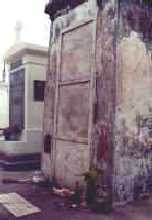
![]()
Prowling the Cities of the Dead
In no other American city do its residents honor the dead as in New Orleans. Often referred to as "cities of the dead" the tombs and crypts of New Orleans have been the talk of mystery, danger, disease, and horror. Enclosed in gates throughout the city, the rusty iron work and ghost-white, stained tombs are adorned with crosses and angelic statues that surround visitors with a world of mystery.
Since the city’s founding, the dead have just never seemed to want to stay below the ground. Corpses buried on the banks of the river frequently washed into the city, and those buried within the city often rose to the surface in floods. Various methods were tried to remedy this problem of rising corpses, such as placing rocks on top of the graves and boring holes in the coffins. It wasn’t until mayor Esetban Miro adopted the Spanish-style wall vaults that New Orleans finally kept its rotting corpses and skeletons off the streets.

![]()
These vaults formed the basis for many of New Orleans’s above-ground burials. The economical vaults are stacked one on top of the other, providing room for countless corpses and generations. The upper class of New Orleans eventually took the burials to another level by building large, ornate tombs with crypts, many appearing to be miniature houses with iron fences and rows of tombs resembling streets. And so they became "cities of the dead".
There are more than 42 cemeteries in the New Orleans area, all with interesting stories and histories. Several of the oldest, most popular, and interesting include:
St. Louis No. 1
Founded in 1789, St. Louis Number 1 is the city’s oldest cemetery. Many historical figures are buried here including Ernst Moral, the city’s first black mayor, the inventor of craps, and the famous (or infamous) voodoo queen Marie Laveau. Flowers, candles, and coins are left at many of the graves, especially Marie Laveau’s, which is marked by "X"s and various phrases and comments.
The "oven vaults" create the front wall of the cemetery. More than 10 feet long, corpses must decay for a year and a day before the skeletal remains are pushed back to make room for more. In some of the elaborate family tombs, the remains are pushed down into the foundation. The wall vaults are often leased to those corpses who do not yet have a space available in the family tomb.
"Society" tombs also dominate much of the St. Louis cemetery, placing souls together in relation to ethnicity, profession, and philosophy. The Italia Tomb near the center of the cemetery is one of the largest in the city. A local student from Tulane University once excavated the remains of more than 160 skulls in one of the society tombs.
After the directors of Easy Rider filmed a morbid scene near the Italia tomb, the Archdiocese of New Orleans carefully scrutinized all filming in the cemetery. Most movies such as Double Jeopardy, Interview with the Vampire, and Dracula 2000 were now filmed in the Lafayette Cemetery. The cemetery is located towards the end of Conti St., past N. Rampart on Basin Street.
The cemetery is surrounded by one of the city’s notorious housing projects, and you are asking for trouble by going alone. Consider taking a guided tour (see below) or traveling in a group, as this cemetery is not in the best of neighborhoods.
St. Louis No. 2

![]()
In 1823, as many residents believed that diseases such as yellow fever were spread by the dead, St. Louis Cemetery was built far from the city center. Larger than St. Louis I, it consists of three separate sections with beautiful iron work and immense walls. One of the favorites here is Dominique You, a pirate captain who served under Jean Lafitte.
St. Louis No. 3
No. 3 seems to be the favorite with the tour groups and is filled with statues and towering tombs. Founded in 1854, it is somewhat similar to East Coast cemeteries with its wide, planned paths, yet the architecture is truly New Orleans.